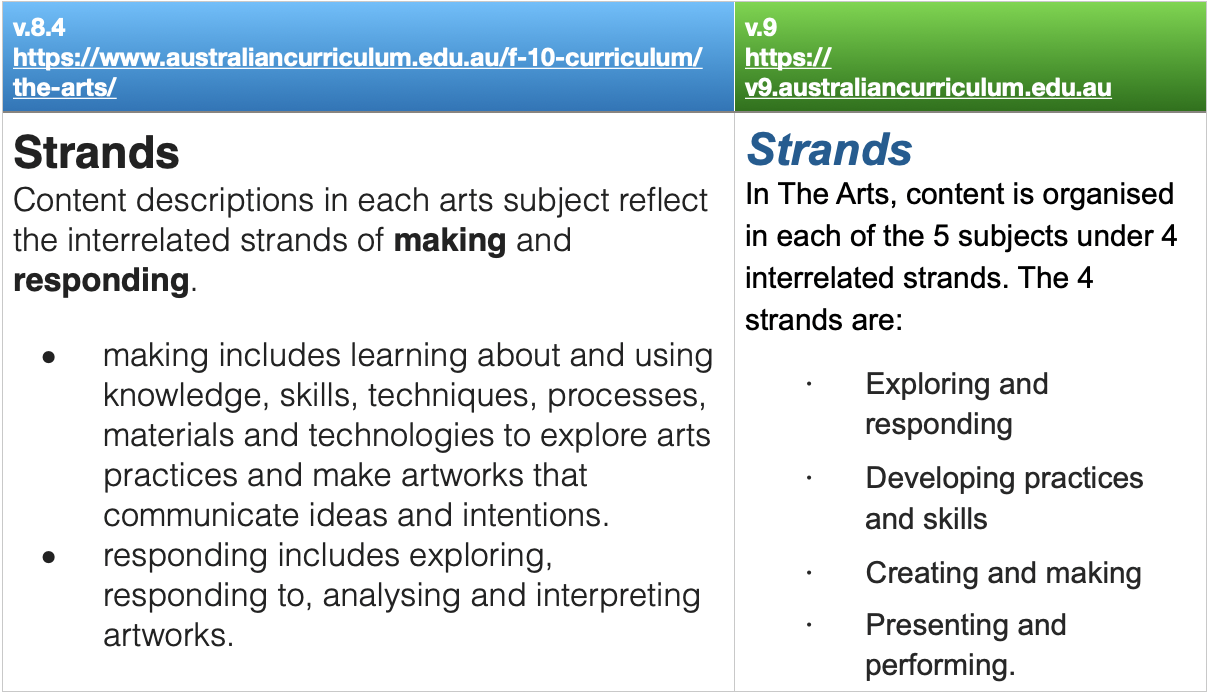Drama Tuesday - Australian Curriculum: The Arts Plus ça change? Oui ou non!
/Australia has two versions of The Australian Curriculum.
Curriculum is contested space. There are too many political fingers in the pie - particularly in the so-called culture wars. The suspicious caste who see a shadow conspiracy lurking in every word have focused mostly on their versions of history and English and largely ignore the Arts. Indifference can be a blessing – particularly in expecting an arts curriculum to be implemented.
Does this revision of the Arts curriculum make a difference?
At one level, there is consistency. At another level there is significant change that should be noted.
What stays the same?
The Curriculum provides a fundamental commitment to an arts education for all young Australians: “The Arts curriculum is written on the basis that all students will study The Arts from Foundation to the end of Year 8”.
But there is the weasel qualification: “State and territory school authorities or individual schools will determine how the curriculum is implemented”.
There is still a commitment to
Getting action beyond pleasant platitudes and meaningful arts education is always a challenge.
Where should we be awake to changes?
The V.9 Arts Curriculum must not be understood as “business as usual”.
The Strands of the curriculum have changed.
There are implicit shifts in what is highlighted and valued throughout the whole document.
Consider the Strands of the two versions:
The naming of parts is more than “silent, eloquent gestures” (as the Henry Reed poem reminds us). What we call things matters. How we organise our thoughts matter.
Teachers work from familiar patterns – habits of thinking or mind, if you will. For the past few years we have trained ourselves to plan and teach using one paradigm (for better or worse) and now the world of thought is changed.
This is more than semantics. Nor is it just a re-visiting of the many arguments amongst the advisory community – for those with long memories the responses to Shape of the Australian Curriculum: The Arts (ACARA 2010) included different structuring organisation. For example,
“Queensland supports the proposition that there are three processes — generating, realizing and responding — that can organise art form learning and the recursive nature of arts learning and arts processes. This reflects existing practice in Queensland”.
That three part structure has resonances in Version 9 strands. The Western Australian Curriculum Framework (1998) identified four learning outcomes (which have some overlap with Version 9 strands):
Arts Ideas: “Students generate arts works that communicate ideas.” (p. 53)
Arts Skills and Processes: “Students use the skills, techniques, processes, conventions and technologies of the arts.” (p. 54)
Arts Responses: “Students use their aesthetic understanding to respond to reflect on and evaluate the arts.” (p. 56)
Arts in Society: “Students understand the role of the arts in society.” (p. 57)
Version 9 is more than just re-working of the previous version. It is a radical conceptual re-think. More than that, there is the shift in focus on making the arts – exploring/practices and skills/creating and making/presenting and performing – and a downplaying of responding.
In writing this, I am not defending the simplistic making/responding model. For all its catchy two part structure, it was flawed. But what I am trying to highlight is that when you change the ways that we think about a curriculum structure, we change the curriculum.
Perhaps, the only saving grace is that the actual implementation of the previous versions of the Australian Curriculum: The Arts have had such limited success that these changes will slip by unnoticed.
No curriculum is worth anything unless it is implemented.
What we have had in successive versions of Arts Curriculum in Australia has not been a failure to write good curriculum, but a failure to implement what is developed.
I urge everyone to read the new version of the Arts Curriculum, with an eye looking back to what was valuable in the past (not forgetting what’s in state/territory documents as well). But also reading Version 9 with criticality and connoisseurship (to invoke Eisner).
We need to ask ourselves two questions:
What changes and what stays the same?
Do the changes matter to a successful arts education for every young Australian?
Bibliography
Costa, A. L., & Kallic, B. (2000-2001). Habits of Mind. Retrieved from http://www.habits-of-mind.net/
Eisner, E. W. (2002). What can eduction learn from the arts about the practice of education? John Dewey Lecture for 2002, Stanford University. Retrieved from www.infed.org/biblio/eisner_arts_and_the_practice_or_education.htm . Last updated: April 17, 2005.







